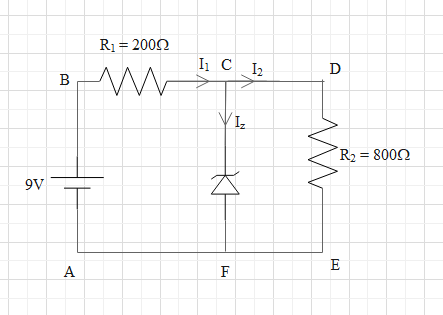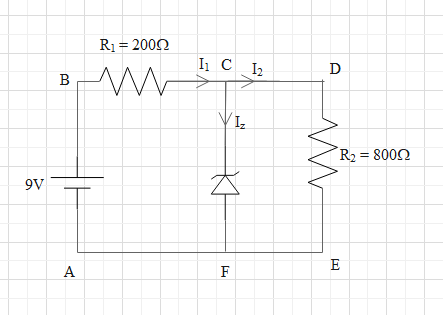
The reverse breakdown voltage of a Zener diode is 5.6 V in the given circuit. The current

A. 7mA
B. 17mA
C. 10mA
D. 15mA

Answer
507.6k+ views
Hint: Use Ohm’s law which gives us the equation V = IR. Kirchhoff's voltage law finds the current flowing in the two resistances. Once you find the current in the two resistances then use junction law to find
Formula used:
V = IR
Complete step by step answer:
Reverse breakdown voltage of a diode is the minimum voltage at which the diode starts to conduct electricity in reverse bias. Otherwise, in reverse biased a diode does not conduct electricity. In other words, it acts as an insulator.
Let the potential difference across the Zener diode be
Let the resistances 200
According to ohm’s law, V = IR.
Let the current passing through resistances

Therefore,
It is given that the current through the Zener diode is
Apply Khircoff’s voltage law in loop ABCF in the direction of current (clockwise direction).
Therefore, we get
It is given that
This implies,
Again, apply Khircoff’s voltage law in loop CDEF in clockwise direction.
Hence we get,
It is given that
This gives,
At point C, there is a junction of three currents,
According to junction law of current,
This gives us that
We found the values of
Substitute the values of
Hence,
Therefore, the current flowing through the Zener diode is 10mA.
Hence, the correct option C.
Note: We can solve the question without knowing Kirchhoff's voltage law.
Assume the potential at the negative terminal of the battery is 0V. Then the potential at the positive terminal is 9V.
The potential difference across the Zener diode is 5.6V. Since the resistance of 800
Therefore,
The potential at point F is 0V. The potential difference across the Zener diode is 5.6 V. Current always flows from higher potential to lower potential and when we go from point F to point C, we go in the opposite direction of the current. Hence, the potential will increase by an amount of 5.6V.
Therefore, the potential at point C is 5.6V.
This gives that the potential difference across resistance of 200
Hence,
At point C, the current
Formula used:
V = IR
Complete step by step answer:
Reverse breakdown voltage of a diode is the minimum voltage at which the diode starts to conduct electricity in reverse bias. Otherwise, in reverse biased a diode does not conduct electricity. In other words, it acts as an insulator.
Let the potential difference across the Zener diode be
Let the resistances 200
According to ohm’s law, V = IR.
Let the current passing through resistances

Therefore,
It is given that the current through the Zener diode is
Apply Khircoff’s voltage law in loop ABCF in the direction of current (clockwise direction).
Therefore, we get
It is given that
This implies,
Again, apply Khircoff’s voltage law in loop CDEF in clockwise direction.
Hence we get,
It is given that
This gives,
At point C, there is a junction of three currents,
According to junction law of current,
This gives us that
We found the values of
Substitute the values of
Hence,
Therefore, the current flowing through the Zener diode is 10mA.
Hence, the correct option C.
Note: We can solve the question without knowing Kirchhoff's voltage law.
Assume the potential at the negative terminal of the battery is 0V. Then the potential at the positive terminal is 9V.
The potential difference across the Zener diode is 5.6V. Since the resistance of 800
Therefore,
The potential at point F is 0V. The potential difference across the Zener diode is 5.6 V. Current always flows from higher potential to lower potential and when we go from point F to point C, we go in the opposite direction of the current. Hence, the potential will increase by an amount of 5.6V.
Therefore, the potential at point C is 5.6V.
This gives that the potential difference across resistance of 200
Hence,
At point C, the current
Recently Updated Pages
Master Class 9 General Knowledge: Engaging Questions & Answers for Success

Master Class 9 English: Engaging Questions & Answers for Success

Master Class 9 Science: Engaging Questions & Answers for Success

Master Class 9 Social Science: Engaging Questions & Answers for Success

Master Class 9 Maths: Engaging Questions & Answers for Success

Class 9 Question and Answer - Your Ultimate Solutions Guide

Trending doubts
Give 10 examples of unisexual and bisexual flowers

Draw a labelled sketch of the human eye class 12 physics CBSE

Differentiate between homogeneous and heterogeneous class 12 chemistry CBSE

Differentiate between insitu conservation and exsitu class 12 biology CBSE

What are the major means of transport Explain each class 12 social science CBSE

a Tabulate the differences in the characteristics of class 12 chemistry CBSE




